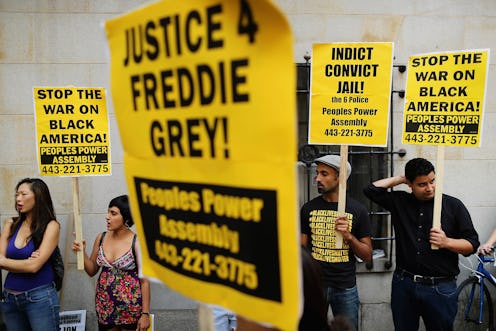News
Freddie Gray's Death, One Year Later
The circumstances surrounding the death of 25-year-old black man Freddie Gray has sparked discussion around the racial injustice that so often devastates the black community. The nationwide dialogue about Gray's death and the issues that accompanied it have helped propel awareness, and on its anniversary, the country can collectively look back on how the last 12 months have unfolded. There have been many developments since the Freddie Gray case began, though at times, it seems as though not much has changed at all.
Gray died on April 19, 2015, having been arrested five days prior by Baltimore Police for allegedly carrying an illegal switchblade,. The details after the arrest were initially murky — while Gray was being taken to jail in a police van, the officers had to switch routes for a trauma center after he slipped into a coma during the ride. After dying several days later, his death was ultimately attributed to injuries sustained to his spinal cord. The six officers involved in the case were suspended with pay three days later, as reported by the New York Times.
Gray's arrest, death, and the officers' pending investigation sparked a series of protests that surged throughout Baltimore for a number of weeks. The protests did not stay localized, either, with multiple demonstrations cropping up throughout the country.
There have been a number of developments in the investigation since it began last April, the largest of these being the state prosecutor charging the six officers held responsible for Gray's death. The charge came down on May 1 of last year, after the death was ruled a homicide by the state medical examiner.
Baltimore City State's Attorney Marilyn Mosby asserts that the officers acted illegally, arresting Gray when he committed no crime (the pocket knife he was carrying was allegedly not a switchblade, and was of legal size). Mosby also alleges that the officers' forceful arrest of Gray led to his severe neck injury, which ultimately resulted in Gray's death — something the Fraternal Order of Police denies.
In May 2015, when the six officers involved in the Gray arrest were taken into custody, Gene Ryan, president of the Fraternal Order Of Police (the "world's largest organization of sworn law enforcement officers" which calls itself "the voice of those who dedicate their lives to protecting and serving our communities"), issued a statement:
Not one of the officers involved in this tragic situation left home in the morning with the anticipation that someone with whom they interacted would not go home that night. As tragic as this situation is, none of the officers involved are responsible for the death of Mr. Gray.
The charges for the officers are listed here:
Here's the status of each of the six officers' trials:
Officer William G. Porter: His first trial in December 2015 was ruled a mistrial after there was a hung jury. After many appeals and reversals, Porter's new trial is slated for September 2016. This might be delayed even more, however. The Washington Post reports that the court has ruled that Porter is able to take the witness stand in the trials of his other officers. Porter's lawyers could appeal that ruling in the Maryland Supreme Court, which would push everything back even more. He's pleaded not guilty.
Officer Garrett E. Miller: He was indicted on two of the three charges (false imprisonment was dropped). His trial is set for July 27, 2016. He's pleaded not guilty.
Officer Edward M. Nero: He was indicted on two of the three charges. As with Miller, false imprisonment was dropped. His trail is set for May 10, 2016. He's pleaded not guilty.
Officer Caesar R. Goodson, Jr: He's been indicted on all charges, and his trial is set for June 6, 2016. He's pleaded not guilty.
Lt. Brian W. Rice: The highest-ranking of all the officers in the Gray case, Rice's trial is set for July 5, 2016. He's pleaded not guilty.
Sgt. Alicia D. White: Her trial is slated for October, 2016, and she's pleaded not guilty to involuntary manslaughter and office misconduct.
Some of the physical remnants of the protests' aftermath have also changed in a year's time. The Baltimore CVS which burned to the ground as the nation watched has since been rebuilt. The city's police vans also now have cameras installed.
But some statistics show that not much has changed. Though the Black Lives Matter movement has championed Gray and the many unfortunately like him, police brutality continues to be a massive problem for minority communities. According to a database compiled by The Washington Post, 68 black individuals have already been shot and killed by police during 2016 alone. The anniversary of Freddie Gray's death nevertheless marks a time for both reflection and action.
